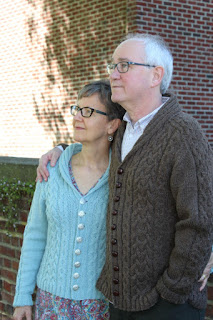General Notes for Fundamental Top-Down Cardigan Patterns
Having recently edited all the Figheadh Fundamental Top-Down Cardigan patterns in the merge to Jen Hagan Design, I wanted to have a place for you to go to receive more help with and information for those projects. These notes are helpful for all Fundamental Cardigan patterns, because each pattern has many yarn weights, gauges, and sizes.
Gauge
The gauges and needle sizes in each section of this pattern are to be used as a general guide. Not all yarns fall squarely into these four distinct categories. Follow the yarn company’s suggested needle size as stated on the yarn label. Also, pay attention to how the manufacturer categorizes the yarn. You may need to vary your needle size to achieve the suggested gauge.
Respect the yarn, however. If by changing needle size you feel that the loft of the yarn is being compromised—causing a tight fabric—or if the resulting fabric is too loose, perhaps you should reevaluate your yarn choice. Be open to adjustment on all these counts in order to achieve the correct gauge.
You may find that even though you have achieved the correct stitch gauge, your row gauge differs from what is suggested in this pattern. Defer to the stitch gauge, because it is the most crucial.
However, the sleeve is one part of the sweater where a differing row gauge will produce problems. If your row gauge is lower than called for (for example, six rows per inch instead of seven), your sleeve will come out longer than it needs to be. To remedy this, measure the sleeve when it is halfway complete; if the measurement is not correct, work your decreases more rapidly than suggested. If your row gauge is too many rows per inch, add more rows between decreases on the sleeve: For instance, if the decrease occurs every other RS row, put in a couple of decreases every RS row to even out your gauge. If your row gauge is not correct, follow all length measurements even more carefully (i.e. body, neckline, sleeve, etc.)
Fit
The numbers in this pattern will yield a standard ease (approximately 4”) for all sizes to produce a casual, comfortable garment. Be sure to check the wearer’s chest measurement and compare to those given at the beginning of each section to ensure the best fit. If you want a closer fit, consider going down a size or reducing the number of stitches cast on across the armhole gap when beginning the lower body.
You may also customize the length by adding inches to the body and the sleeves. One advantage of a top-down garment is that you may stop at any point in the project, place the live stitches on a long piece of scrap yarn, and try on the sweater. You can decide on length for a more custom fit to the wearer. You can also alter the garment later—as in the case of a child who has grown taller—by taking out the edging and adding a few inches before reworking the edges. This is a good reason to purchase an extra skein or two of yarn when you choose it for this project.
Edging
The 1/1 rib gives some shaping to the cuffs, collar, and hems of this sweater. If you want the cuffs and hem to be fashioned more loosely, simply change the edging to garter stitch. Button and buttonhole bands may also be worked in garter stitch to match the cuffs and hem if you choose this option.
Neckline
The V-neck edging is simple because it is worked all at once from one lower edge around to the other. One way to assure accuracy is to affix a stationary marker at the point of the last neckline increase. This way you may be sure of the top button placement. Also, as with any picking up of stitches along the side of knitted fabric, the formula is three stitches out of every four rows for gauges 6, 5, and 4. For gauge 3, pick up two stitches for every three rows.
Stitch Pattern
This sweater is worked in Stockinette stitch, which is knit on the RS and purled on the WS. The edges are worked in 1/1 rib (k1, p1; rep). Raglan increases on this sweater are worked as kf&b, k1 before the marker and kf&b after the marker because the kf&b increase causes the effect of a k1, p1. This raglan increase produces one knit stitch on each side of each marker. The sleeve decreases are worked one stitch from the inside “seam.”
I removed this part of the pattern with the edit, so I have added a link in the patterns so you can still find this helpful information. Enjoy your cardigan project with confidence!

Comments